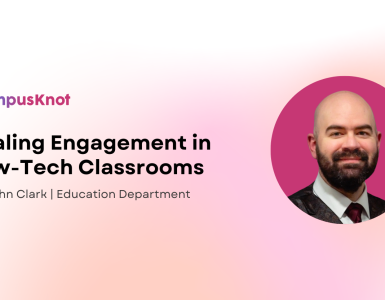Education is evolving, and so are the approaches to teaching and learning. A human-centered approach in education is gaining momentum as it focuses on placing learners’ needs, preferences, and experiences at the forefront.
One crucial element of this approach is social presence, which creates an inclusive and engaging environment for learners. In this blog, we explore the concept of social presence and discuss effective strategies for implementing it in medium and large in-person classes.
The Power of Social Presence
Imagine a classroom where students feel connected, engaged, and motivated to learn. This is what social presence aims to achieve. Social presence refers to the sense of being connected to others and perceiving their presence, even in the absence of physical proximity. While often associated with online environments, social presence can be fostered in traditional face-to-face classes, creating a positive and inclusive learning community.
Strategies for Promoting Social Presence
- Building Positive Relationships: Encouraging interactions and fostering positive relationships among students and between students and instructors is a vital step in creating social presence in class. Ice-breaking activities, group projects, and team-building exercises can help establish a sense of community within the class.
- Facilitating Open Communication: Providing opportunities for students to express their thoughts, ideas, and opinions and actively listening to them promotes social presence. Engaging classroom discussions, debates, and active participation encourage students to connect with each other and the subject matter.
- Creating a Supportive Learning Environment: A positive and inclusive classroom climate where students feel respected, valued, and supported enhances social presence. Setting clear behavior expectations, promoting diversity and inclusion, and addressing conflicts or challenges contribute to a supportive environment.
- Providing Feedback and Encouragement: Regular feedback and encouragement contribute to students’ sense of social presence by acknowledging their contributions and recognizing their efforts. Providing constructive feedback on assignments, acknowledging participation, and offering positive reinforcement cultivates a supportive environment.
Choosing the Right Technology Tools
Technology can play a pivotal role in fostering social presence in in-person classes. It’s crucial to ensure the pedagogical alignment, the familiarity of both instructors and students with the technology, and the availability of resources and infrastructure.
Tools that foster online discussions, polling or survey tools, multimedia creation platforms, or social media-like platforms that align with your instructional goals and enhance the learning experience. A group worth exploring is the student response system, which combines multiple features into one software. CampusKnot offers a set of tools to automate the grading and tracking of class participation while integrating with your LMS.
Creating Inclusive and Engaging Learning Environments
Humanizing medium and large in-person classes may seem challenging, but it is indeed achievable. By adopting a human-centered approach and prioritizing social presence, instructors can create a learner-centric environment where students feel connected, engaged, and valued.
Incorporating strategies to build positive relationships, facilitate open communication, create a supportive learning environment, promote engagement, and provide feedback is essential.
Download our conversation with Dr. Jim Tokuhisa on Taking a human-centered approach in medium and large in-person classes using social presence strategies & technology.








